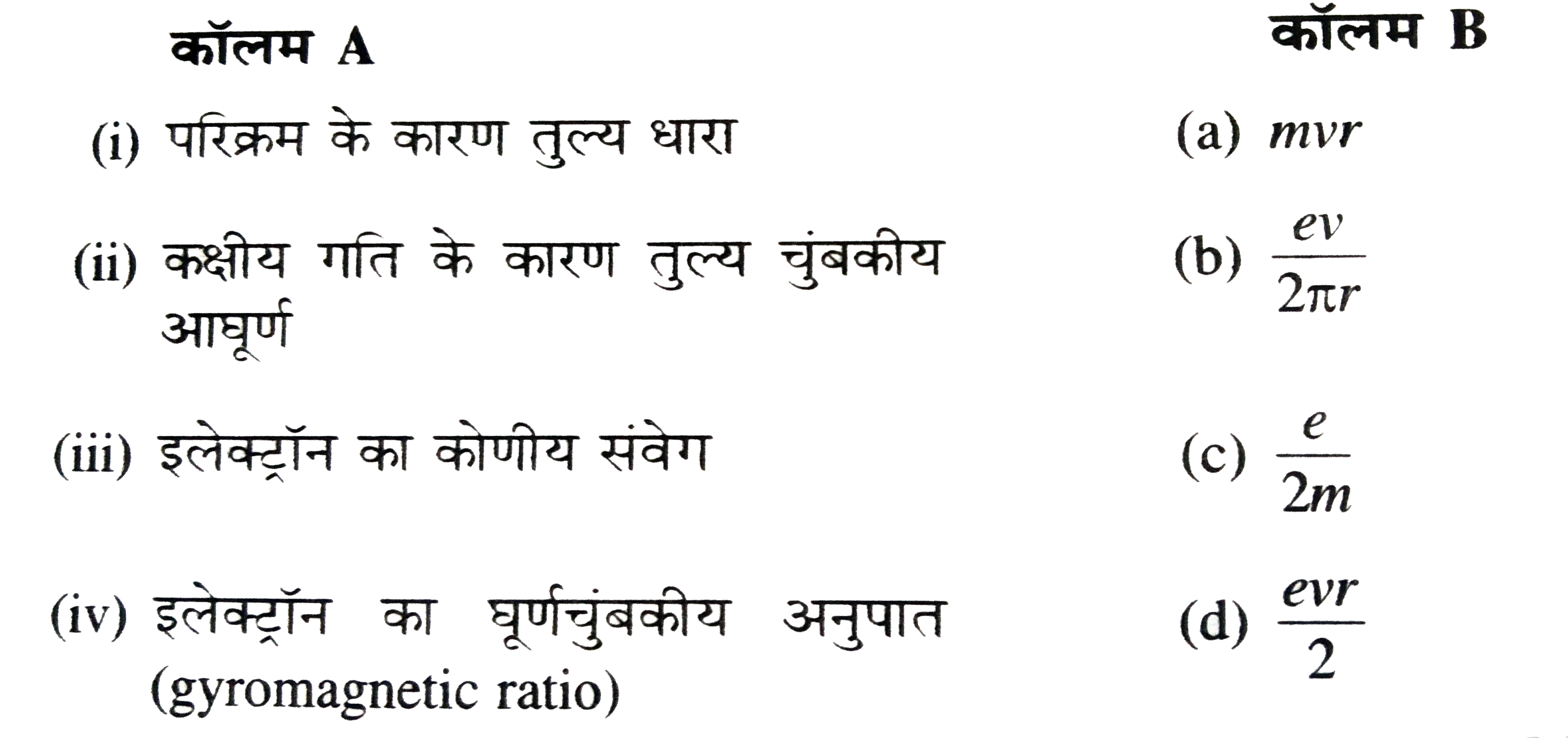An electron (charge =-e ) is revolving around a nucleus along a circular path of radius r with frequency f . What will be the magnetic moment of the electron due to its orbital motion ? Solution in Bengali
Number of complete revolutions per second = f .
So , the the amount of charge flowing through any point on the orbit per second = effective current (i) = ef .
Therefore , the required magnetic moment ,
pm=IA=ef.πr2.
Topper's Solved these Questions
- BOOK - CHHAYA PUBLICATIONCHAPTER - Magnetic Properties of Materials EXERCISE - NCERT TEXTBOOK QUESTIONS WITH ANSWER HINT21videos
Magnetic Properties of Materials
- BOOK - CHHAYA PUBLICATIONCHAPTER - Magnetic Properties of Materials EXERCISE - NCERT EXEMPLAR QUESTIONS WITH ANSWER HINT (MCQ-1)4videos
Magnetic Properties of Materials
- BOOK - CHHAYA PUBLICATIONCHAPTER - Magnetic Properties of Materials EXERCISE - Section Ralated Questions7videos
Magnetic Properties of Materials
- BOOK - CHHAYA PUBLICATIONCHAPTER - LIGHT WAVE AND INTERFERENCE OF LIGHT EXERCISE - CBSE SCANNER15videos
LIGHT WAVE AND INTERFERENCE OF LIGHT
- BOOK - CHHAYA PUBLICATIONCHAPTER - OPTICAL INSTRUMENTSEXERCISE - CBSE SCANNER8videos
OPTICAL INSTRUMENTS
Similar Questions
Answer the following questions regarding earth's magnetism
Name the three independent quantities conventionally used to specify earth's magnetic field .03:50View SolutionThe magnetic field of earth can be earth can be modelled by that of a point dipole placed at the centre of the earth . The dipole axis makes an angle of 11.3∘ with the axis of earth . At Mumbai , declination is nearly zero . Then
05:23View SolutionDefine magnetic moment of a bar magnet .
03:22View SolutionIn Young's double slit experiment derive the condition for (i) constructive interference and (ii) destructive interference at a point on the screen.
02:13View SolutionDefine the magnifying power of a compound microscope when the final image is formed at infinity . Why must both the objective and the eyepiece of a compound microscope has short focal lengths ? Explain.
02:05View SolutionAn electron of charge e moves in a circular orbit of radius r round a nucleus the magnetic field due to orbit motion off the electron at the site of the nucleus is B. The angular velocity ω of the electron is
02:37View Solutionनाभिका के चारों ओर वृत्तीय कक्षा में घूमते हुए इलेक्ट्रॉन (आवेश e , द्रव्यमान m ) का कक्षीय वेग v , आवर्तकाल T तथा पथ की त्रिज्या r है ।
 01:44View Solution
01:44View Solutionहाइड्रोजन परमाणु में एक इलेक्ट्रॉन नाभिक के चारों ओर 0⋅5Å की अक्ष में परिक्रमा करता है । यदि इलेक्ट्रॉन के परिक्रमण की आवृत्ति 6⋅6×1010 प्रति सेकण्ड हों , तो इलेक्ट्रॉन की कक्षीय गति के करण गति के कारण परमाणु का चुंबकीय आघूर्ण कितना होगा ?
View SolutionAn electron of charge 'e' is revolving in a circular orbit of radius r around a nucleus with speed v. The equivalent current is
01:32View SolutionThe orbital speed of an electron orbiting around the nucleus in a circular orbit of radius r is v. Then the magnetic dipole moment of the electron will be
04:21View SolutionIn a hydrogen atom , an electron of charge e revolves in an orbit of radius r with speed v . Find the magnetic moment associated with the electron .
View SolutionAn electron of charge e is moving in a circular orbit of radius r around a nucleus, at a frequency v. The magnetic moment associated with the orbital motion of the electron is
02:57View SolutionIf an electron revolves around a nucleus in a circular orbit of radius R with frequency n, then the magnetic field produced at the centre of the nucleus will be
02:11View Solutione आवेश वाला एक इलेक्ट्रॉन, v आवृत्ति के साथ नाभिक के गिर्द r व्यासार्ध की एक वृत्ताकार कक्षा में घूमता है। इलेक्ट्रॉन की कक्षीय गति के कारण चुम्बकीय आघूर्ण है ।
01:24View SolutionWhen electron revolves around nucleus in a circular orbit, its orbital magnetic moment is ______
01:35View Solution

